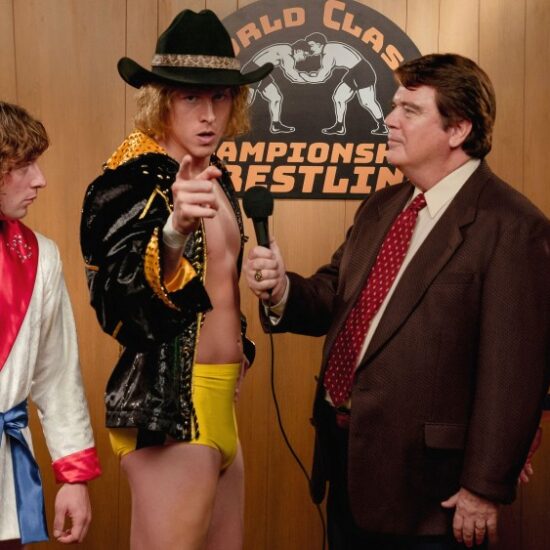
The ending of William Shakespeare’s “Measure for Measure” has forever posed a question that has challenged directors, actors and theater companies alike: How does one deal with silence? As an act of defiance, perhaps? Or a moment of rebellion? Or is it a sign of reluctant acceptance, an acknowledgment of defeat despite what has been won?
Jessica Kubzansky‘s “Measure Still for Measure” at Boston Court Pasadena wrestles, too, with this question. Her new text, built upon the bones of Shakespeare’s original, sees a cast and director grappling with an unconventional approach to “Measure for Measure’s” finale, one that has forever stripped the lead female character, Isabella, of a voice. In Kubzansky’s play it’s a choice that has reverberations beyond just the stage, raising questions about power, agency, what it means to be an ally, and a woman’s right to independence.
Isabella in the Shakespeare text has been put through a wringer. The situation of her brother Claudio — he’s sentenced to death for having sex out of wedlock — has sent her into despair. A sexual proposition can save him, one that also comes from the very autocratic man who has passed hypocritical judgment on Isabella’s sibling. It’s an insult, and an offer that will take not just her sovereignty but commit her to the same patriarchal cycle of sin and corruption that saw Claudio imprisoned.
Kubzansky’s “Measure Still for Measure,” now running through Oct. 15, does not aim to simply mediate on the Shakespeare work. The Boston Court production — an immersive staging that asks the audience to move through rehearsal areas, the parking lot and to watch part of the production in the lobby — uses the ending as a springboard. How much, if any, has changed since the early 1600s? It does this not by giving us a Shakespearean — or Harvey Weinstein-like villain — but by showing us the structures of power in a modern workplace, in this case a theatrical production, where a young actor playing the part of Isabella (Bukola Ogunmola) is forced to juggle her career, her values and her own mind when allies are in short supply.
Bukola Ogunmola as Dionna/Isabella in “Measure Still for Measure,” now running at Boston Court Pasadena.
(Brian Hashimoto)
I revisited Shakespeare’s “Measure for Measure” before seeing Kubzansky’s play, and I would recommend at least a crash course in the original before viewing the Boston Court production. But that also meant I went into Boston Court feeling a slight sense of defeat — despite Shakespeare’s Isabella defying the norms for much of the play, eventually the norms catch up to her.
“I understand the defeat,” says Kubzansky, describing the Shakespeare play as a “beast.” “Slowly, you start to understand what all the machinations are about. You get more inside it and you get co-opted by it a little. I understand the initial sense of defeat, and then it’d be very interesting to know that if you spent a longer time with a production that is fully realized, how would you feel about it.”
Kubzansky’s play introduces us to a respected but overbearing theater director in Bruce (Robert Beitzel), who just so happens to also be playing the duke in the play-within-the play. In his role in the latter, he must interact heavily with Ogunmola’s Dionna/Isabella. We learn earlier that Bruce is a director many actors desire to work with, and his approach to Ogunmola’s characters in the first act — friendly, but perhaps a bit too comfortable for a professional setting — start to raise an eyebrow.
By skirting the lines of acceptability, Ogunmola’s Dionna is left to wonder whether her concerns are simply machinations of her own mind. Later rehearsals with her as Isabella prove they are not, but where some may see harassment others witness a brilliant actor-director at work. Boundaries are pushed, but perhaps they are done so in the name of artistic excellence?
“I was interested in all the shades of gray,” Kubzansky says. “How a woman could feel gaslit by her own. I don’t think there’s a woman I know, myself included, who is highly aware that there is something happening to me that is not happening to my fellow male colleagues. Even when I brought it up to other women, they’ve been like, ‘Nooo! Definitely not.’ We’re all participants of this white supremacist paternalistic system. All of us tend to see in those rules and perimeters. Everyone is seeing from that same lens because it’s the lens that has been the rules of the world for quite some time. So I was truly hoping this was as gray as it could be.”
By opting for an immersive production, that is, one in which the audience can for part of the show roam the venue and follow certain actors, Kubzansky also lays bare the vulnerability inherit in the creative process, but also likely present for anyone in any hierarchical professional setting. We see, for instance, the absolute devastation when someone is left out of a roll call of compliments.
And close to actors we can hear conversations with their parents or significant others, learn of affectations some performers would prefer better left secret and get an early glimpse at Bruce’s planned ending for the troupe’s “Measure for Measure.” Bruce’s take is one that has Isabella, a Shakespearean character who has dedicated herself to the church, acquiescing to the duke’s surprise marriage proposal, a twist that the actor playing Isabella finds uncomfortable, so much so that Dionna is nervous to challenge Bruce on the unorthodox reading of the play.
I’d argue the immersive nature of the first act heightens the intimacy among the performers, allowing the more traditional presentation of act two to carry more weight. We have the illusion of knowing the character’s innermost thoughts by seeing them act in natural settings in and around the theater. Kubzansky wants to experiment with the form, but also wanted to make clear that this is not a production in which we will engage in conversation with the cast, as the hope is we will feel invisible and voyeuristic rather than a part of the show.
But how to stage a show is an important question, Kubzansky says, to be asking in 2023, especially as theaters shutter or alter production plans due to a lack of recovery from the pandemic. “Storytelling is in our lizard brains,” Kubzansky says. “Theater is never going to go away, but the interesting question is, what makes a performance? What makes a play? Does it have to be in four walls?”
Kubzansky, an artistic director at Boston Court, has been weighing some way to tackle the themes of “Measure for Measure” at the Pasadena theater for years. Current events, and the #MeToo era, have only fueled her belief that the Shakespeare text is ripe for a dissection of the type her reworking undertakes. While the days of being jailed for having sex before marriage may be long gone, the rights and the freedoms of the LGBTQ+ community are a matter of debate in certain states, and a woman’s right to choose is once again a part of our political cycle and at risk. And these conversations, as they are in “Measure in Measure,” are often being led by men.

Jenapher Zheng, from left, as Frankie, the assistant director, Desiree Mee Jung as Alexis, the stage manager, and Rob Beitzel as Bruce, the director.
(Brian Hashimoto)
“We’re in such a fascinating moment in our cultural history,” Kubzansky says. “We’re in the middle of a giant course correction. Old methodologies and ways of behaving are no longer acceptable. There is no question it depends on where in the generational spectrum you live how easy new forms of respectful behavior are for people.”
The play aims to explore the fascinating and challenging new rules of engagement, most especially in theater but also in society,” Kubzansky says. “It’s a challenging moment to be navigating in the world and trying to navigate safely, respectfully, inclusively and everything else. People are failing at it all the time, with the best will in the world.”
As Kubzansky’s “Measure Still for Measure” progresses, the parallels between the new work and the Shakespeare text become heightened, especially when it comes to Isabella. But there are also notable differences. Her monster — Bruce — is a complex figure, one who in many ways is a force for good. After all, he has cast a diverse showing of “Measure for Measure,” and he has taken a play with few roles for women to be one that centers the female voice. Additionally, he also has opened debates for outdated Shakespearean turns of phrase, and appears willing to change them without much fuss.
Is his offensive, harassing behavior, then, simply the result of coming of age in a different theatrical era? And does it even matter if it’s offensive to so much as one?
“I know what I think, but I’m not sure I should tell anyone because I think this is a conversation that, unless you get to be inside each of those character’s heads, I’m not sure you get to know,” Kubzansky says. “I will say that directors probably have a slightly different perspective. I was also putting myself on trial, by the way. I am often and primarily a director, and I was acknowledging my positional authority and the inherent power dynamics that are a part of that. That is something to contend with. It is a very real power imbalance in the room.”
As a director, Kubzansky says, “We fail repeatedly. We lay awake at night. ‘I should not have handled that that way. I should have tried this approach.’ Running a room, has a lot of responsibility.”
And as “Measure Still for Measure” makes clear, a lot of space for things to go wrong.
‘Measure Still for Measure’












